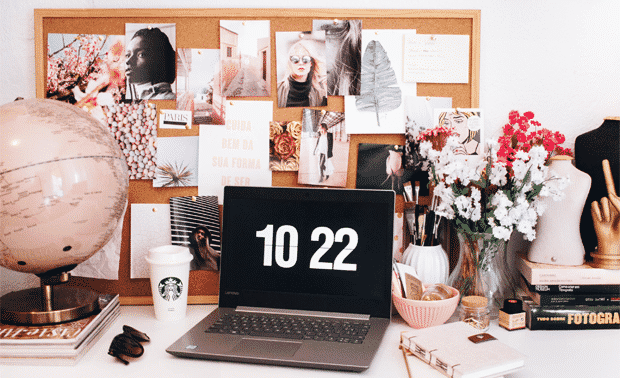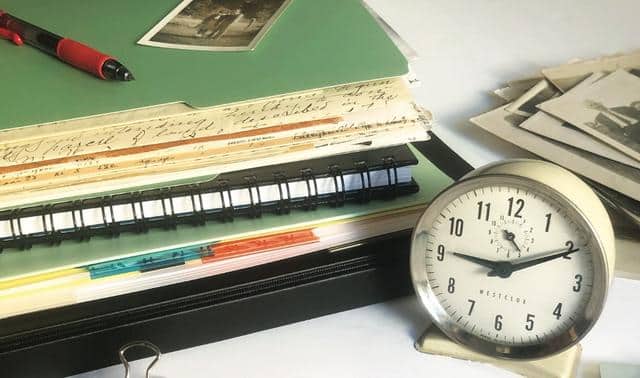
When you sit down to work on your genealogy, can you pick up where you left off? Or do you get distracted by the clutter around you? Do you forget whether you already requested Great-great-grandma’s obituary? Pause to hunt for your notebook and a pen? A streamlined workspace—whether it’s a whole spare room or a corner that doubles as bill-paying central—will make your genealogy research more organized and productive.
The right setup and tools for the way you work can make the difference between jumping right into a research session and spending 20 minutes getting ready to begin. Our inside look at the workspaces of six professional genealogists reveals the office arrangements, tools and best practices that promote research efficiency. Discover tips, tricks and new ideas to help you make your workspace and your workflow more, well, workable.
Semi-Circular Command Center
Photo Detective Maureen A. Taylor keeps up on her many projects from a large semicircular desk nestled in the bay window of her Victorian home. It’s a setting genealogists might envy, but it wasn’t always this way for the photo consultant, author and speaker. Taylor’s first home office was a door perched atop two file cabinets, a DIY desk setup familiar to many home researchers. In her next house, she upgraded to an office in a three-season porch with the same desk and an additional side surface to make an L. “It sorta worked,” she remembers.
But when Taylor moved again, she looked forward to improving her home office setup and was inspired by Rhode Island genealogist Midge Frazel, who also works at a semicircular desk. Taylor’s “command center” puts equipment and files within easy reach, with built-in bookcases and file cabinets on one side, and a cork board and whiteboard on another. Her desktop computer, flatbed scanner and telephone sit on the desk.
A typical day begins at 7:30 a.m.: checking email, flagging important messages and building the day’s to-do list. She may take her dogs for a walk, returning to work until about 6 p.m. doing research for client photos or writing projects. Taylor calls her office style “controlled.” She admits to a “to-do pile on my desk at all times” but she knows exactly what she needs to do when, using a system of paper, pencil and written reminders. She uses a large monthly paper calendar for appointments and notes, and keeps a running to-do list for each day or week. “As things pop up during the day, they get added to the list,” Taylor says. Much of her day is spent closely examining photographs, so she sets up a large folding table for extra workspace as needed. Reference books are organized by topic on nearby bookshelves, but she’s already running out of space. “There’s never enough storage,” Taylor says, adding that another set of bookcases to hold her ever-growing collection is the new next thing on her list.
A Neat Research Niche
Sunny Jane Morton is a busy wife, mother of three and author who has re-purposed a niche in her master bedroom into a unique writer’s studio. Tucked under the eaves of her family home, this home office is a bright and cheery spot decorated with family photos and genealogy research mementos. In her family’s previous home, Morton worked from the kitchen table and a small counter nearby. “I knew that buying lots of organizational supplies doesn’t make you organized,” she says. “I needed a dedicated space.” She now has a sturdy desk and a low bookcase that holds her most-used reference books and office supplies (stored in cheery yellow boxes). More bookcases in the hallway hold her genealogy library.
Although Morton’s home office is upstairs and away from the bustle of her busy family, she’s never far from inspirational reminders of her own family history. She calls the wall next to her desk the “identity collage,” a place to post conference name tags, seminar certificates, notes from her children, and a valentine from her grandmother, who passed away in 1995. Looking at those things, she says, “reminds me to get up and go to my real life.” As an editor, writer and researcher who spends hours in front of a computer, Morton admits that turning the pages of a real book is a welcome change of pace. She seeks out print books on topics she’s researching, but also keeps a digital library of books and other materials she finds online.
Morton likes paper and books, and has no plans to go paperless. “I’m a hybrid,” she says, “I’m OK with it. If it starts digital, I keep it digital.” But with working time at a premium, she doesn’t want to spend the time digitizing print materials to create a paperless office. Being disciplined about keeping her desk neat helps her maintain a workspace that fits her multiple personal and professional roles—a key to her success. “I did have to clean my office,” she laughs, “but I truly think that if there’s a foundation of organization under a haze of clutter it’s a lot easier to find stuff.”
Ergonomic Writer’s Office
As a consultant, speaker and writer, Thomas MacEntee brings the best lessons of the corporate workplace to his website, Genealogy Bargains. From a structured workday that spans 8 a.m. to 6 p.m. to an ergonomically aware setup, MacEntee strives to maximize efficiency and minimize distractions.
Whether he’s consulting with clients via Skype or broadcasting a webinar to a distant genealogy society, MacEntee relies on core technology that keeps his workspace free of equipment clutter. “I’m the king of multiple tabs and windows,” he laughs about using multiple monitors with his Windows computer. From multiple tabs to multitasking, MacEntee is an alpha geek at getting the most out of his equipment.
Space is at a premium in MacEntee’s 1,500-square-foot condo, so each piece of office equipment or storage is carefully chosen. A monitor sits at eye level. He places any printed material he’s using at the same distance, reducing eyestrain from switching views. An adjustable desk chair brings him to a comfortable keyboard position, and a bookcase holds reference material within easy reach. Plenty of task and overhead lighting makes the office easy on the eyes.
MacEntee optimizes storage space by utilizing digital copies as much as possible, storing files on an external hard drive and in an online Dropbox account. “I’m pretty much paperless,” he notes, although he prefers not to store financial or medical information in the cloud.
In fact, the only paper in sight is neatly contained in one “In” basket. “If it’s in a pile of clutter I’m going to forget it,” MacEntee says. Must-keep papers go in a single basket that he files twice a year. To save business travel receipts, he takes along an envelope labeled with the trip name and drops in receipts as received. Life isn’t all bytes and hardware in this office. A set of speakers plays online radio or musical selections from MacEntee’s extensive iTunes collection, and original artwork on the wall is daily “incubation inspiration” for the next project of this self-professed “genealogy ninja.”
A Dual-Function Office
Drew Smith, co-host with George G. Morgan of the Genealogy Guys Podcast, admits to a Jekyll and Hyde office personality. As a full-time librarian at the University of South Florida, as well as a popular genealogy speaker, podcast personality and author, Smith has offices where he works and in his Tampa, Fla., home.
At work, he uses large white boards for taking notes while brainstorming and meeting with colleagues. But he also relies heavily on cloud storage with Dropbox and its integration with favorite applications, so he can move files seamlessly between his work and home computers.
“I’m easily distracted,” Smith notes,” so I need to keep things in front of my face so I don’t ignore them.” His personal reminder system works as well for paper files and folders as it does for digital filing. He uses the Evernote note-taking app to organize notes about photos, blogs and articles; the Toodledo online task application to maintain an ongoing to-do list; and Gmail to manage email communication.
Smith takes advantage of Gmail’s tagging system to label important messages with the date of the related event in year-month-day format. This makes it easy to find all emails relating to a particular conference or seminar. After the event, he renames the tag following the format Gmail-Event Name-Year, and the tag drops down in the alphabetized listing. He uses a similar folder naming scheme for his Dropbox folders to organize digital documents he needs for an event.
Telecommuting gives Smith the opportunity to work on library projects from home, although he tries to reserve Saturdays as his genealogy day—whether he’s presiding at his local genealogical society’s meeting or doing personal research in his home office. There, an L-shaped desk provides a distraction-free workspace that he keeps cleared off and ready for work. Currently, that entails an ongoing family photo-scanning project, part of his move toward a paperless home office.
Tip: Smith files paper records and notes by couple, with large labels for readability (capitalizing the full last name helps, too). The numbers on his labels correspond to each ancestor’s ahnentafel number on a pedigree chart.
Genealogy-Friendly Home Office
Author, speaker and co-host of the Genealogy Guys Podcast, George G. Morgan is no “mouse potato” when it comes to running a successful business from a home office. Long before telecommuting was a common workplace option, Morgan’s home office did double duty for his work as a corporate trainer at IBM and his own genealogy research.
When he founded his full-time genealogy writing and speaking business, Aha! Seminars, in 1996, he had already mastered the challenges of staying on-task and organized when the “break room” is next door and coworkers aren’t around to keep tabs. “Many people have problems maintaining focus and become distracted,” Morgan says of working from home. “But it’s really a matter of discipline, and of using to-do lists to help you see the big picture.”
Morgan is in his office by 8 a.m. with his daily list, answering email, checking websites and working on research and writing projects straight through until 6 p.m. A self-confessed neatnik, he puts his large L-shaped desk to good use by keeping supplies and projects within easy reach, from frequently used office supplies stored in a side hutch to nearby reference books.
It’s no surprise that Morgan’s first job was shelving books in the town library. His Morgan Shelving System, as he calls it, is a mini-library organized on three bookcases. Genealogy and reference books are arranged by category, region and research type. “It’s not the Dewey Decimal System,” he says, but the system saves time in locating books he needs—which he can then spend on his personal research.
Despite his orderly books and to-do list, Morgan is quick to note it’s important to make your home office comfortable and enjoyable. “Don’t be too Spartan,” he says. “Don’t try to be too neat.”
A Clutter-Free Setup
When Genealogy Gems Podcast host Lisa Louise Cooke relocated to another state, that move came with the chance to set up her dream office in a new home. Her new space is twice as large as the old one, and she’s relocated her inventory and shipping department to a separate building.
Eliminating clutter—anything that doesn’t belong to the task at hand—is one of Cooke’s favorite strategies for maintaining focus. “Pull out of the space what doesn’t apply to your research or business,” she says. “Everything has to have a place, and you won’t have so many piles.”
Her new office offers plenty of places to store what she needs for her podcasts, writing and presentations. One of her favorite features is the large desktop that conceals the wiring and cables for her computer and broadcasting equipment. Cooke is thrilled to be rid of what she calls the “snakepit” of cables and cords that were once a visual distraction and a tripping hazard.
With her emphasis on removing clutter, Cooke has migrated to a paperless work style. She replaced her wall bulletin board with inspirational family collages. Her reminders are now online, with Google Calendar as her primary calendar and time management tool. A single online tool, Cooke says, means fewer places to look for information.
Cooke schedules as much as possible using Google Calendar app reminders so she won’t miss important deadlines. Appointments for the Genealogy Gems Podcast, other work and family are color-coded. “The principles are the same, whether they’re on paper or virtual,” she adds. Built-in triggers such as colors work as reminders, whether you’re writing them on paper or adding them to an online calendar.
As much as Cooke enjoys her new office, cloud computing and online access give her mobility when traveling or working from a comfortable chair in the family room. She dictates emails with her iPhone, runs her desktop computer remotely from her iPad, and reads news and blogs on either device. “Ten years ago you couldn’t create a podcast,” she says. “You couldn’t be a stay-at-home mom speaking to the entire world.” Clearly, it’s a great time to be a tech-savvy genealogist.
Related Reads
A version of this article appeared in the May/June 2014 issue of Family Tree Magazine. Last updated: November 2024








